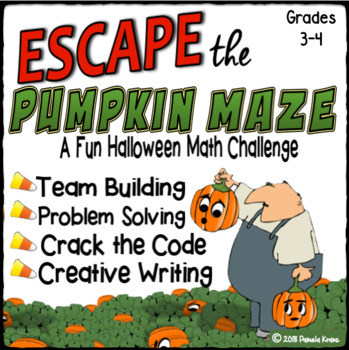Halloween Escape Room Math - 3-digit Addition & Subtraction Crack the Code
- PDF
Description
Looking for a fun alternative to engage your kids this Halloween? Escape the Pumpkin Maze is just what you were looking for! This fun team-building math escape room challenge has something for everyone.
The adventure starts when YOU, the most awesome teacher on the planet, plan a fun trip to Paddy's Pumpkin Patch. With all the activities they feature, you are certain your kids will have a terrific time.
Unfortunately, the Pumpkin Maze is under a spell and your kids become trapped inside. The only way out is to complete the challenges and break the spell before time is up!
The comic book format sets up this exciting adventure where they complete a series of 4 challenges.
==========WHAT IS INCLUDED?==========
♦ At-a-glance instructions for EASY set up and organization.
♦ Crack the Code puzzle that challenges them beyond simple addition and subtraction, using the following math skills:
• Addition & subtraction of 3-digit numbers
• Inverse operations
• Multi-step equations
• Ordering from least to greatest
♦ Trick or Treat Mix Up! A Sudoku-like visual spatial puzzle
♦ Acrostic Poem activity with takeaway bookmark that walks kids through the steps of writing an acrostic poem.
♦ Pumpkin Patch Riddles, a fun decoding activity
♦ At-a-glance answers.
♦ Reflective exit slips.
♦ Awards to celebrate a successful escape.
==========WHAT DO I HAVE TO SUPPLY?==========
You will only need a few folders, scissors and possibly some glue (if you choose that route). Unlike other breakout activities, you don’t have to go out and buy expensive locks and boxes, because everything you need is included. Just print and go!
==========WHAT MAKES THIS SPECIAL?==========
The storyline is interactive and immersive. YOUR students are directly involved in the story. If used as a pre-assessment or review, it will provide you with a perfect opportunity to discern where everyone is in their understanding of these concepts. All of our escapes resources are great to use for an observation.
==========HOW LONG DOES IT TAKE?==========
Completing the entire escape will take 50-60 minutes. Students will not have to leave the room. This is NOT a scavenger hunt.
Have fun and be sure to come back for more escape room challenges!
Thanks for stopping by! Pam Kranz
***************************************************************************
© Pamela Kranz Desktop Learning Adventures All Rights Reserved





